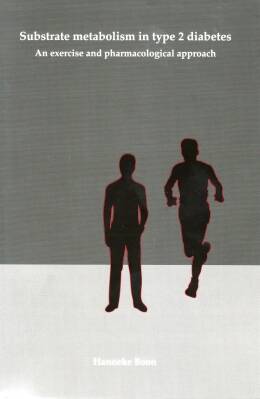Thesis Hanneke Boon

Substrate netabolism in type 2 diabetes
An exercise and pharmacological approach
Type 2 diabetes mellitus (T2DM) is a disease diagnosed by hyperglycemia but characterised by severe disturbances in the regulation of both glucose and fat metabolism. A high energy intake and low energy expenditure through low physical activity are important risk factors fot the development and progression of T2DM. Enlarged adipose tissue may have a decreased capacity to adequately take up and store dietary fatty acids (FA), leading to increased plasma FA flux to non-adipose tissues including skeletal muscle. This is particularly precarious when levels of physical activity and skeletal muscle FA oxidative capacity are decreased, as storage of these FA is then more likely to occur. This accumulation of lipids and subsequent formation of lipid metabolites may disturb cell function an induce or exacerbate insulin resistance in skeletal muscle. Exercise and exercise training may positively affect the disturbances in supply, uptake and oxidation of FA and carbohydrate, e.g. by increasing glucose uptake, FA oxidation and skeletal muscle FA oxidative capacity and by decreasing FA release. This occurs at least in part through pathways mediated by th AMP-activated protein kinase (AMPK). The AMPK pathway is not only an interesting target for the study of metabolic regulation in response to exercise, but also for pharmacological intervention. This thesis includes a series of studies on disturbances in glucose and fatty acid metabolism in type 2 diabetes mellitus and investigates two approaches to prevent and/or correct these disturbances exercise and pharmacological targetting of the insulin-independent AMPK pathway.
Hanneke Boon, October 14th 2009

